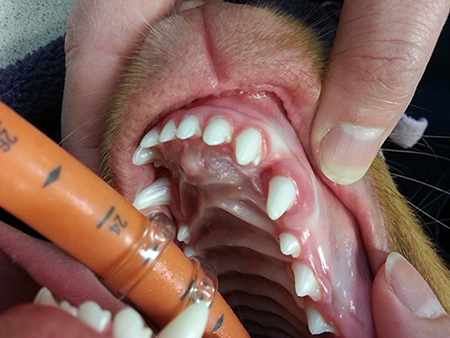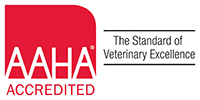Maintenance of good general health in your dog requires that their oral health care be properly addressed. If your dog has significant gingivitis and tartar/calculus accumulation on their teeth a complete dental evaluation and dental cleaning (above and below the gum line) will be recommended. If your veterinarian diagnoses severe periodontal disease, which involves obvious root exposure or loose teeth, an immediate dentistry should be scheduled. In order to perform a proper dental evaluation and scaling (cleaning) a general anesthetic is required.
 We are aware that many people are somewhat hesitant to have their pet anesthetised, however anesthesia-free dentistry provides a false sense of security. Many articles have been written on this subject and the American Veterinary Dental College has a great website with much information, including “Dental Scaling Without Anesthesia” (see link: http://www.avdc.org/dentalscaling.html). When only the crowns are cleaned (which is all that is possible and legally permitted with anesthesia-free dentistry), it is assumed that all is going well beneath the gingival margin. However this is often not the case. It is the subgingival area that requires the most attention during a dental cleaning. This subgingival area, 360 degrees around the tooth, is the least accessible in a conscious patient. Without an evaluation and cleaning (subgingival curettage and root planning) of the subgingival area, serious infection can continue under the gum line resulting in severe periodontal disease, tooth infection/abcessation and eventual loss of teeth. Many of our animals do not clearly indicate that they have significant mouth and or tooth pain.
We are aware that many people are somewhat hesitant to have their pet anesthetised, however anesthesia-free dentistry provides a false sense of security. Many articles have been written on this subject and the American Veterinary Dental College has a great website with much information, including “Dental Scaling Without Anesthesia” (see link: http://www.avdc.org/dentalscaling.html). When only the crowns are cleaned (which is all that is possible and legally permitted with anesthesia-free dentistry), it is assumed that all is going well beneath the gingival margin. However this is often not the case. It is the subgingival area that requires the most attention during a dental cleaning. This subgingival area, 360 degrees around the tooth, is the least accessible in a conscious patient. Without an evaluation and cleaning (subgingival curettage and root planning) of the subgingival area, serious infection can continue under the gum line resulting in severe periodontal disease, tooth infection/abcessation and eventual loss of teeth. Many of our animals do not clearly indicate that they have significant mouth and or tooth pain.
After the physical exam, your veterinarian will consider and discuss with you the risks and benefits of a thorough oral examination and professional cleaning (with possible extractions if required) for your pet. Safety is paramount in considering if a dental, including a general anesthesia, is in the best interest of your dog. There are a number of steps and precautions taken with every animal that undergoes a dental procedure.
- Pre-anesthetic blood evaluation: Given a general anesthesia is required; the doctor will recommend an evaluation of your dogs’ blood to ensure he or she is healthy enough to undergo the procedure. Depending on the findings your veterinarian may wish to begin certain medications (including antibiotics), and or institute additional precautions before the anesthetic and dental procedure. There are situations where your veterinarian may feel that the risks of anesthesia are too great and thus medications, including antibiotics and pain management are what may be recommended instead.
- General Anesthesia: Safety is improved by placement of an intravenous catheter and administration of intravenous fluids prior to and during the complete procedure. This allows your veterinarian to maintain proper hydration for your pet, blood pressure and quickly administer medications when needed. At Scottsdale Veterinary Hospital, it is our experienced Animal Health Technologists (AHT) who is responsible for closely monitoring all of our patients under anesthesia. This includes maintaining a complete record of the animals’ heart rate, blood pressure, respiratory rate, and body temperature.
- Dental Evaluation and Cleaning: Once anesthetised, the veterinarian individually assesses every tooth (a dog should normally have 42), at multiple sites, around the tooth utilizing a periodontal probe. If required, dental radiographs are taken to better evaluate the degree of periodontal disease, horizontal/vertical bone loss and possible root abscesses. Many board certified veterinary dentists feel that all dental patients should have full mouth intraoral dental radiographs. Once the mouth and teeth are assessed, those teeth that do not require extraction will be scaled/cleaned both above and below the gum line by our AHTs. Currently we have 5 specially trained AHTs which have taken significant extra training dealing with the skills and proper techniques involved in animal dentistry. We routinely utilize both ultrasonic and hand scalers. Many people will attest to the variable discomfort that occurs when cleaning under the gingival margin, which is why our patients must be anesthetised to complete this correctly.
- Dental Polishing: No matter how carefully the teeth are scaled, microscopic scratches will be on the surface of the tooth enamel. It is important for us to individually polish the entire surface of each tooth with a prophy cup filled with paste. Understandably if the patient is awake for the cleaning procedure those scratches and damage to the enamel will be a lot greater. Upon completion of the cleaning and polishing the veterinarian rechecks the teeth and proceeds with those teeth requiring extraction.
- Tooth Extraction: The veterinarian or specially trained AHT will now utilize a local anesthetic to block or “freeze/numb” the area around the tooth to be extracted. This is the same type of procedure a human dentist would do to work on your teeth. Given tooth extraction can be quite painful, a nerve block not only helps with pain control but improves safety as we do not have to increase the level of gas anesthetic. This local anesthetic lasts for several hours after waking the patient and thus they recover much more comfortably. The doctors will also have the AHT give our patients additional doses of pain medications as required intravenously throughout the procedure. Once properly blocked, the veterinarian will complete the extraction of the tooth/teeth. The gum tissue is gently elevated away from the tooth and jaw to improve visualization and extraction. All teeth which have more than one root (26 of the 42 teeth have two or more roots) will be cut utilizing a high speed dental drill. Sectioning of the tooth and its roots allows improved ability to remove the entire tooth and its roots without breaking them. It is crucial that the entire root is removed to minimize later complications. Each tooth root is removed utilizing sharpened instruments called elevators. We need to have many sizes of these dental elevators to accommodate the varying sizes of teeth/roots we encounter. Once the extraction is completed the empty socket is rinsed with an antibacterial solution called chlorhexidine and the elevated gum tissue or flap is sutured closed. These sutures or stitches are self “dissolving” so they do not have to be removed by the veterinarian.
- Post-Operative Dental Care: Every patient is recovered from anesthesia in an area we call our treatment room, under the care and monitoring of our AHTs. This area is where most of the activity of the doctors and AHTs takes place. Each animal is given an individual kennel with a clean bed and or blanket to recover in quietly. They are always covered with a second warm blanket and given additional warming devices if required. Generally we will offer them a small snack once they are fully awake as many of our patients are quite hungry after missing their breakfast the morning of the dental procedure.
We will provide you with written instructions on the proper care of your pet and their teeth upon picking up your dog. Either your veterinarian or an AHT will go over all of the instructions and any concerns you may have. If extraction of teeth were required, there will be additional pain medication to go home with. For those patients requiring a major dentistry resulting in extractions, your veterinarian will offer a complementary re-evaluation of your dog’s mouth generally within 10 to 14 days of the dental procedure. This is to ensure that proper healing of the mouth and minimization of pain is attained for each and every patient.


